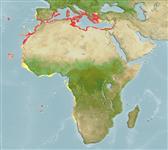>
Eupercaria/misc (Various families in series Eupercaria) >
Sparidae (Porgies)
Etymology: Diplodus: Greek, diploos = twice + Greek, odous = teeth (Ref. 45335).
More on author: Walbaum.
Environment: milieu / climate zone / depth range / distribution range
Sinh thái học
Biển; Thuộc về nước lợ Sống nổi và đáy; Ở đại duơng, biển (Ref. 51243); Mức độ sâu 0 - 150 m (Ref. 2683), usually 0 - 60 m (Ref. 3688). Subtropical; 42°N - 28°S, 26°W - 42°E
Eastern Atlantic: Bay of Biscay (rare) to Sierra Leone, the Canary Islands, and Cape Verde, including the Mediterranean and Strait of Gibraltar and Black Sea (Ref. 4781). Also off South Africa.
Bộ gần gũi / Khối lượng (Trọng lượng) / Age
Maturity: Lm ? range ? - ? cm
Max length : 60.0 cm TL con đực/không giới tính; (Ref. 3397); common length : 30.0 cm TL con đực/không giới tính; (Ref. 3688); Khối lượng cực đại được công bố: 1.7 kg (Ref. 40637)
Benthopelagic marine species. Gregarious species living in coastal waters on rocky or sandy bottoms, up to 1 50 m (only occasionally over 50 m). Younger individuals can also be found in brackish waters and may live in littoral pools (sometimes in brackish waters and lagoons), the adults often occur in the surf zone. Feeds on seaweeds, worms, mollusks and shrimps (Ref. 4781). Very common in the Mediterranean. In the Atlantic occurs from Gibraltar to the coasts off Sierra Leone, including the coasts of the Canary Islands and Cape Verde. Less often found off the Iberian Atlantic coasts and Bay of Biscay. Scarce in the Black Sea. Permanent hermaphrodite species with some protandric episodes (behaving as male after its first sexual maturity to become female later on). Reproduction happens by the end of the summer and autumn. Egg size 0.85 mm, larval length at hatching 1.7 mm.
Bauchot, M.-L. and J.-C. Hureau, 1990. Sparidae. p. 790-812. In J.C. Quero, J.C. Hureau, C. Karrer, A. Post and L. Saldanha (eds.) Check-list of the fishes of the eastern tropical Atlantic (CLOFETA). JNICT, Lisbon; SEI, Paris; and UNESCO, Paris. Vol. 2. (Ref. 3688)
IUCN Red List Status (Ref. 130435)
Threat to humans
Harmless
Human uses
Các nghề cá: Tính thương mại; cá để chơi: đúng
Các công cụ
Special reports
Download XML
Các nguồn internet
Estimates based on models
Preferred temperature (Ref.
123201): 16 - 21.6, mean 19.1 °C (based on 294 cells).
Phylogenetic diversity index (Ref.
82804): PD
50 = 0.5000 [Uniqueness, from 0.5 = low to 2.0 = high].
Bayesian length-weight: a=0.01202 (0.00979 - 0.01476), b=3.04 (3.01 - 3.07), in cm total length, based on LWR estimates for this species (Ref.
93245).
Mức dinh dưỡng (Ref.
69278): 3.2 ±0.0 se; based on diet studies.
Generation time: 4.1 ( na - na) years. Estimated as median ln(3)/K based on 1
growth studies.
Thích nghi nhanh (Ref.
120179): Trung bình, thời gian nhân đôi của chủng quần tối thiểu là 1.4 - 4.4 năm (tm=3).
Fishing Vulnerability (Ref.
59153): Moderate vulnerability (40 of 100).
Climate Vulnerability (Ref.
125649): Low to moderate vulnerability (30 of 100).
Nutrients (Ref.
124155): Calcium = 55.7 [32.5, 101.4] mg/100g; Iron = 0.89 [0.51, 1.53] mg/100g; Protein = 19.3 [18.4, 20.3] %; Omega3 = 0.383 [0.203, 0.729] g/100g; Selenium = 33.3 [17.0, 57.5] μg/100g; VitaminA = 11.3 [3.7, 29.7] μg/100g; Zinc = 0.88 [0.62, 1.22] mg/100g (wet weight); based on
nutrient studies.
